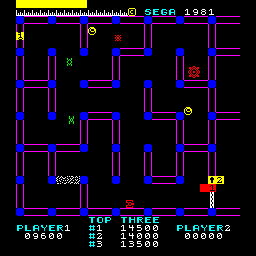 The Game: You control a tank – though it seems like an awfully tiny one – zipping through a maze teeming with enemies. Three color-coded keys are tucked away in a corner, and after grabbing one of these keys you must fight your way past enemy forces to open the corresponding lock. The process must be repeated until all of the keys on a given level have been used, allowing you to travel to the next portion of the maze – where more keys, more locks and more enemies await. Additionally, shooting some enemies may have an effect on your tank’s speed, causing it to move event faster through the maze (and potentially face-first into trouble) or slowing it down to the point where it’s a nearly defenseless target for the enemy. (Sega, 1981)
The Game: You control a tank – though it seems like an awfully tiny one – zipping through a maze teeming with enemies. Three color-coded keys are tucked away in a corner, and after grabbing one of these keys you must fight your way past enemy forces to open the corresponding lock. The process must be repeated until all of the keys on a given level have been used, allowing you to travel to the next portion of the maze – where more keys, more locks and more enemies await. Additionally, shooting some enemies may have an effect on your tank’s speed, causing it to move event faster through the maze (and potentially face-first into trouble) or slowing it down to the point where it’s a nearly defenseless target for the enemy. (Sega, 1981)
Memories: Somewhere between Tank! and Mouse Trap lies Pulsar, an intriguing and oddly compelling hybrid of game elements. If you missed this one in the arcade, don’t worry: you weren’t alone. Given the surfeit of maze games that were marketed to amusement operators as a cure for the epidemic of Pac-Man fever, there were a lot of games that looked like Pulsar. Besides, in 1980, cute was king, slide-and-shoot derivatives of Space Invaders were still “in,” and tank games that happened not to be Battlezone were so 1974.


It probably didn’t help Pulsar‘s case for popularity that its variety of enemies, each with their own characteristics, and its fast action imparted a rather steep learning curve on the game. If someone blew 75 cents just to confirm that they sucked at Pulsar, they’d find something else to play (and they’d tell their friends to steer clear too).
 Pulsar also has an unusual feature for a dedicated arcade game: screen flicker. In the opening moments of any given level, when both the player’s tank and all of the enemies were still present and accounted for, it seemed to be a little too much for the game’s hardware to handle. Flickering sprites – an indication that the number of moving objects on the screen was overpowering the cental processor’s ability to keep track of, draw and animate them all – was a problem more commonly associated with home video game consoles, and was fairly rare in arcade hardware, which was usually custom-built to ensure that it could handle all of the requirements of the game it was designed to play. It’s therefore possible that Pulsar was a rush job implemented on a hardware platform originally designed to
Pulsar also has an unusual feature for a dedicated arcade game: screen flicker. In the opening moments of any given level, when both the player’s tank and all of the enemies were still present and accounted for, it seemed to be a little too much for the game’s hardware to handle. Flickering sprites – an indication that the number of moving objects on the screen was overpowering the cental processor’s ability to keep track of, draw and animate them all – was a problem more commonly associated with home video game consoles, and was fairly rare in arcade hardware, which was usually custom-built to ensure that it could handle all of the requirements of the game it was designed to play. It’s therefore possible that Pulsar was a rush job implemented on a hardware platform originally designed to  play an earlier game.
play an earlier game.
Still, Pulsar is rather fun, and not quite worthy of the obscurity it seems to have earned.